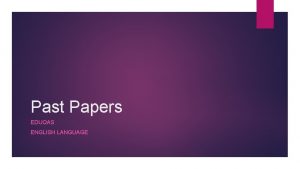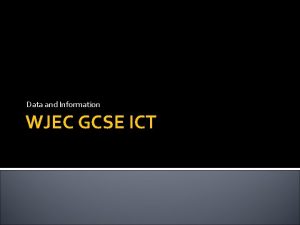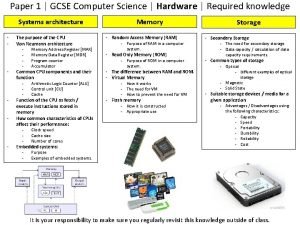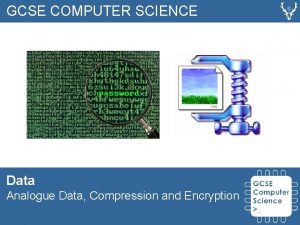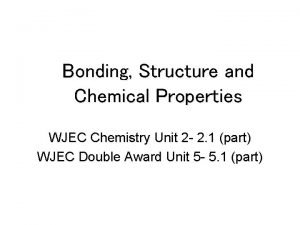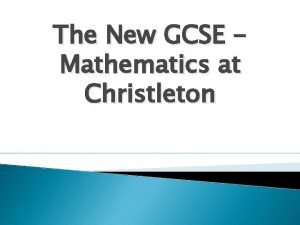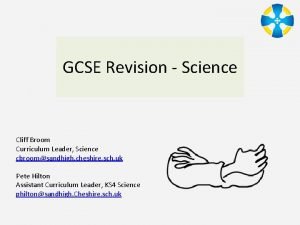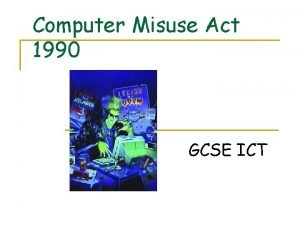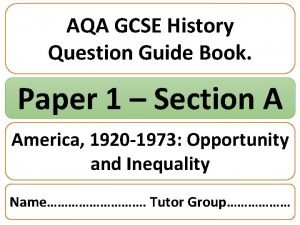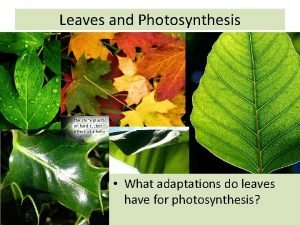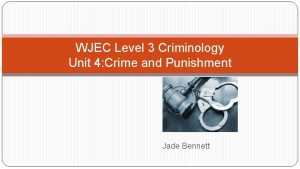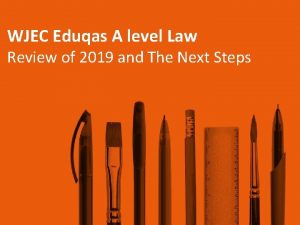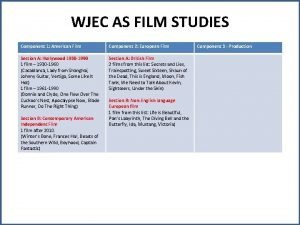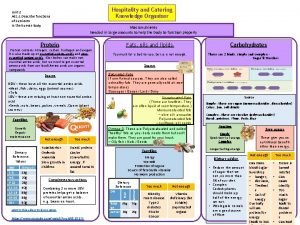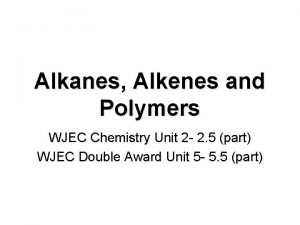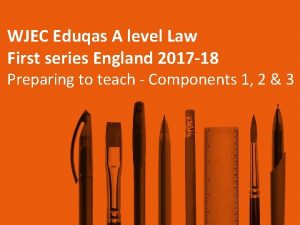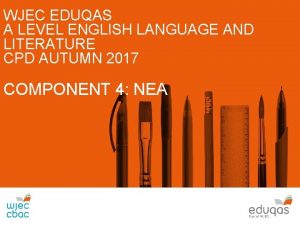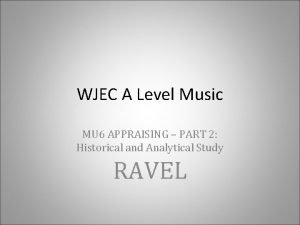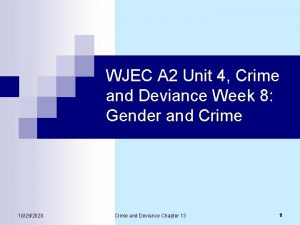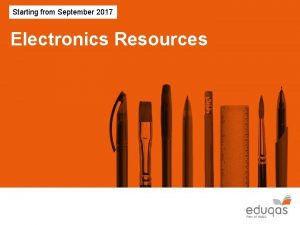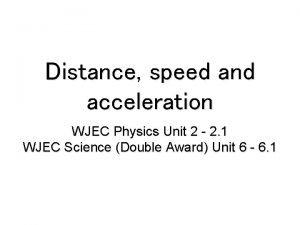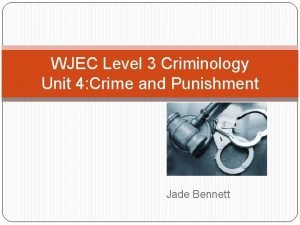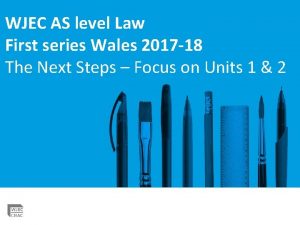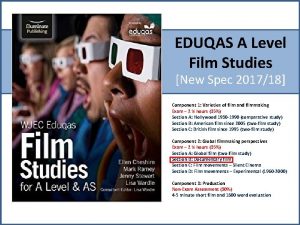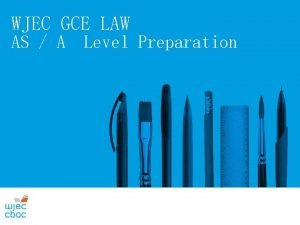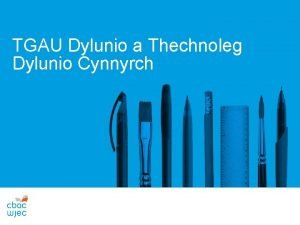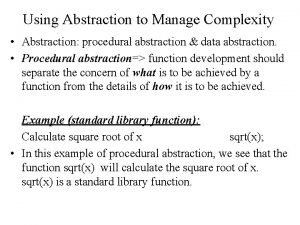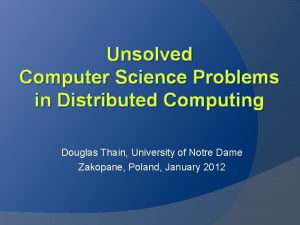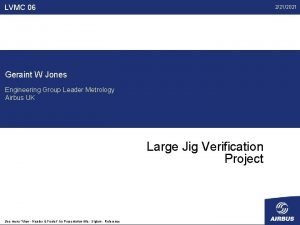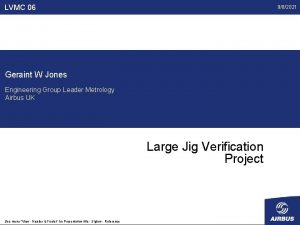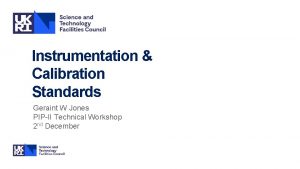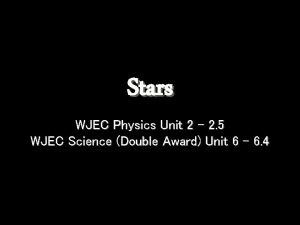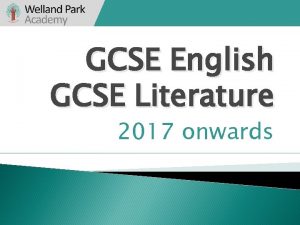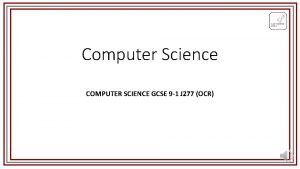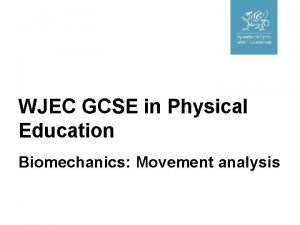WJEC GCSE Computer Science Geraint Jones Principal Structure








































































- Slides: 72

WJEC GCSE Computer Science Geraint Jones Principal

Structure of qualification • Course is linear with 3 units o Theory examination o Practical examination o NEA (non-exam assessment) • Summer examinations only (No winter resit opportunities) • Programming languages have been limited to: • Component 2 – Java in Greenfoot • Component 3 o o o Basic derived (e. g. VB, Small Basic, Qbasic) C derived (C, C++, C#) PHP Python Pascal/Delphi

Structure of qualification Unit 1: Understanding Computer Science Written Examination: 1 hour 45 minutes • 50% of qualification • 100 marks • Comprises hardware, logical operations, • communication, data representation and data types, operating systems, principles of programming, software engineering, program construction, security and data management and the impacts of digital technology on wider society

Structure of qualification Unit 2: Computational Thinking and Programming On-screen examination: 2 hours • 30% of qualification • 60 marks • Comprises problem solving, algorithms and • programming constructs, programming languages, data • structures and data types and security and authentication

Structure of qualification Unit 3: Software Development Non – exam assessment 20% of qualification 80 marks This component requires learners to produce a programmed solution, analyse the problem, design a solution to the problem, develop a final programmed solution, test the solution and give suggestions for further development of the solution. Throughout the production of the solution learners are required to produce a refinement log that evidences the development of the solution.

Structure of qualification • Unit 1: • Theory paper, written examination • Unit 2: • On-screen examination • Secure accounts • Questions on paper, answers required electronically (an on-screen booklet) o HTML o Assembly (mnemonics in spec) o Algorithms (writing, debugging, dry running) Functionality of algorithm could be drawn from across spec. o Programming in Java within the Greenfoot environment - will need to install the IDE • Submission by electronic media • Files required in examination supplied in advance to centre to install/test (exemplar copies included with CPD file)

Structure of qualification Unit 3: • Non-examined assessment • Marks submitted via IAMIS • Sample identified automatically • Submission via electronic media • Sample moderated

Resources Currently in Development/translation • Teacher’s guide provides ideas for teaching and guidance on assessment • Notes/text book covering new specification • WJEC, in conjunction with other bodies provide teaching resources online • • http: //resources. wjec. co. uk/ • Teacher engagement with schools collectively producing materials and support, please sign up (name, email, areas of specific specialism) • CPD offered annually in a cycle with dedicated trainers • Specimen materials and specification available at: • http: //www. wjec. co. uk/qualifications/computer-science/

Resources Also available

Online Exam Review (OER) This innovative online resource will allow teachers to continue to receive a high standard of Continuing Professional Development (CPD) in a new and interactive way. This is free, additional resource to face CPD and examiners’ reports. • Gives clear breakdown of candidate performance, including facility factors of questions, percentage attempt and mean mark • Examiner comments provided on a per-question basis • Provides examples of questions and marks awarded • Links to mark scheme • Can be used as CPD material within a department or as a teaching tool • http: //oer. wjec. co. uk/

Online Exam Review (OER) Statistics provided at a granular level for all examinations

Online Exam Review (OER) Examples of candidate answers, with marks, discussion and links to mark scheme

Any Questions? Contact Subject Officer: Andy Parker andy. parker@wjec. co. uk Subject Support Officer: Kwai Wong kwai. wong@wjec. co. uk

WJEC GCSE Computer Science Geraint Jones Principal

Structure of qualification Unit 1: Understanding Computer Science Written Examination: 1 hour 45 minutes • 50% of qualification • 100 marks • Comprises hardware, logical operations, • communication, data representation and data types, operating systems, principles of programming, software engineering, program construction, security and data management and the impacts of digital technology on wider society

Structure of qualification • AO balance and implications for content examination.

Structure of qualification Topics that could make essay style answers or:

Structure of qualification Conventions in specification:

Structure of qualification Appendix of specification:

Structure of qualification Short essay and long form answers:

Structure of qualification Example of mark scheme response:

Structure of qualification Example of mark scheme response:

Structure of qualification Example of mark scheme response:

Structure of qualification Data types can be assessed in many ways:

Structure of qualification

Structure of qualification All will be available in teacher guide – page 26 & 27 & 28

Structure of qualification Considered a difficult topic by candidates:

Structure of qualification Compression:

Structure of qualification Example question on compression:

Structure of qualification Example question on compression:

Structure of qualification TCP IP – consulted with HE/FE, teachers and industry 5 layer model agreed

Structure of qualification Teacher guide:

Structure of qualification Boolean algebra and identities:

Structure of qualification Simplify using rules or truth tables, but must use the method stated in the question. If no method is stated then either approach is accepted.

Structure of qualification DNS System: Conceptual and operational:

Structure of qualification

Structure of qualification Questions on Unit 1?

Structure of qualification Unit 2: Computational Thinking and Programming On-screen examination: 2 hours 30% of qualification 60 marks Comprises problem solving, algorithms and programming constructs, programming languages, data structures and data types and security and authentication.

Structure of qualification Unit 2: • On-screen examination • Secure accounts • Questions on paper, answers required electronically (an on-screen booklet) o HTML o Assembly (mnemonics in spec) o Algorithms (writing, debugging, dry running) Functionality of algorithm could be drawn from across spec. o Programming in Java within the Greenfoot environment - will need to install the IDE • Submission by electronic media (Optical preferred) • Files required in examination supplied in advance to centre to install/test (exemplar copies included with CPD file)

Structure of qualification HTML – from specification

Structure of qualification HTML: • Staggered approach to question. Identify tags, explain tags, use tags etc. • Markup language being examined not artistic presentation/design flair.

Structure of qualification HTML – from SAM

Structure of qualification Assembly languages

Structure of qualification Assembly questions

Structure of qualification Algorithm questions: A series of questions with a staggered approach: • • • Identifying, Dry running, Fixing, Writing, Explaining.

Structure of qualification Specification gives constructs and usage examples for any algorithms used by the WJEC. Candidates not required to use this convention and any pseudocode will be accepted.

Structure of qualification Flowcharts

Structure of qualification Question

Structure of qualification Java within the Greenfoot environment. • Specification is now explicit in stating JAVA object oriented programs. • Programs may be provided by the WJEC for use within this on screen examination. • Programs from the WJEC should be tested by the technical staff at the Centre before the examination, however, none of the contents should be disseminated/accessed by candidates before the examination.

Structure of qualification For example, candidates could be required to: • • • Create a new Greenfoot world Populate a given world with one or more objects Edit the objects so that they turn and move randomly Edit the program code to make the objects move in the direction of the arrow keys when pressed Edit the objects to detect object collision and remove these objects from the world Add a sound which will play when objects requires it to Add objects which can receive messages from other objects Edit objects so that they can change the image/value displayed on the Greenfoot world Save completed worlds as file names stated

Structure of qualification Specification

Structure of qualification Unit 2 – SAM Materials provided by WJEC include: • SAM example Greenfoot files • Worked Greenfoot SAM example

Structure of qualification • Candidates should be prepared to: • Understand be able to explain the concepts used within JAVA just like identifying sections of algorithm/HTML (Q 1) • Create new Worlds within Greenfoot and populate these worlds using Java code or the environment generated JAVA code.

Structure of qualification Unit 3: Software Development Non – exam assessment 20% of qualification 80 marks This component requires learners to produce a programmed solution. analyse the problem, design a solution to the problem, develop a final programmed solution, test the solution and give suggestions for further development of the solution. Throughout the production of the solution learners are required to produce a refinement log that evidences the development of the solution.

Structure of qualification Unit 3: • • • Non-exam assessment Marks submitted via IAMIS Sample identified automatically Submission via electronic media Sample moderated • Controlled conditions – No writing frames, guides, documents, templates etc.

Structure of qualification Administrative aspects of controlled assessment • Assessment grids • Submission of assessments • Annotation and supporting evidence • Supervision and authentication • Collaboration control • See page 15 – 21 of specification and page 39 on Teaching guide.

Structure of qualification Feedback control • Supervising teachers may only provide support if a candidate’s work is such that it prevents them from progressing • Supervising teachers must not give feedback on how to improve work if they are able to move forward • Only certain sections of the work are suitable for feedback.

Structure of qualification • Feedback control • Scope of the problem • Cannot – break down requirements or decompose the problem • Can - give support to identify high-level data, processing and outputs to allow progression • Design • Can – give support to develop a minimal functional system that may not meet all requirements.

Structure of qualification • Refinement log • Feedback must not be provided • Effectiveness of solution • Supervising teacher must not provide any code for the solution • Can – support candidates in high level terms of the syntax • Cannot – provide examples of their use

Structure of qualification • Technical quality • Feedback must not be provided • Testing strategy • Supervising teacher can give high level indication of areas of the solution that should be tested • Cannot give hints on how to test or provide any test data • Testing and Further Development sections • Feedback must not be provided

Structure of qualification Unit 3 – Software Development • • Scope of the problem Design Effectiveness of the solution Technical quality Test strategy Testing Further development Refinement log

Structure of qualification Section 1 – Scope of the problem • Description of the given scenario in terms of input, processing and output • Objectives, including measurable success criteria for the proposed system.

Structure of qualification Section 2 – Design Descriptions of: • Input and output facilities required to produce a user interface • Data structures that will be required • Documentation of the following routines using a standard convention (pseudo code or flowchart): • validation routines • data handling and processing • authentication

Structure of qualification Section 3 – Software development • Annotated listing(s) of all programming code • Evidence of the user interface

Structure of qualification Section 4 – Test strategy • Description of the test strategy • Description of the purpose of unit, integration and functional testing • Test plan and test data Section 5 – Testing • Evidence of test outcomes with commentaries

Structure of qualification Section 6 – Further development • Discussion of the outcomes of the testing • Description of the successful features of the solution and identification of areas for further development • Suggestions for extensions to the solution

Structure of qualification The Refinement Log • The refinement log is an integral part of the project and should be completed during each session. • The purpose of the log is for candidates to demonstrate that they are working in a logical and systematic manner. • Candidates are expected to record any issues encountered and how these issues were addressed.

Structure of qualification Coursework • Help files • Only help files native to the programming language • Where help files are online, relevant help file image may be installed locally • Can use a clean copy of pseudo code conventions (Page 36) • Can use a glossary of syntax of a language but must be high level with no examples of segments of code

Structure of qualification Coursework • Use of libraries • Should avoid the use of pre-compiled units, libraries or modules • However, can be used where functionality is beyond scope of GCSE – would not be acceptable to use a library function to sort data. • Where when used, candidates must explain the functionality of the code used. • Candidates must record the source of the library in their report and the function(s) used and supply an electronic version of the library with their program

Structure of qualification Assessment: • Assessment grids use a best fit approach • Horizontal grids in the Teachers’ Handbook • Explain assessment decisions where necessary

Board set scenario • • One scenario will be available for each cohort – issued at the beginning of the GCSE study in Y 10. SAM scenario. Through the controlled task the candidates are required to complete a design log.

Any Questions? Contact Subject Officer: Andy Parker andy. parker@wjec. co. uk Subject Support Officer: Kwai Wong Kwai. wong@wjec. co. uk
 Gcse computer science wjec
Gcse computer science wjec Wjec gcse electronics
Wjec gcse electronics Eduqas english language past papers
Eduqas english language past papers Wjec gcse ict
Wjec gcse ict Eduqas english literature specification
Eduqas english literature specification Media studies gcse coursework
Media studies gcse coursework Hardware gcse computer science
Hardware gcse computer science Worksheet 2 searching algorithms answers
Worksheet 2 searching algorithms answers Compression computer science
Compression computer science Computational thinking gcse
Computational thinking gcse Gcse computer science paper 2
Gcse computer science paper 2 Wjec applied science single award
Wjec applied science single award Bonding structure and properties wjec
Bonding structure and properties wjec Hashim: what's your favorite subject
Hashim: what's your favorite subject Jones gulch science camp
Jones gulch science camp Welcome back mrs
Welcome back mrs Basic structure of computer in computer organization
Basic structure of computer in computer organization Https://vle.mathswatch.co.uk/vle/
Https://vle.mathswatch.co.uk/vle/ Combined science gcse grades
Combined science gcse grades Science gcse exam
Science gcse exam Computer misuse act gcse
Computer misuse act gcse Gcse pe 9 marker structure
Gcse pe 9 marker structure How to answer gcse history questions aqa
How to answer gcse history questions aqa Plant
Plant Cross section of a leaf
Cross section of a leaf Wjec hospitality and catering unit 2 examples
Wjec hospitality and catering unit 2 examples Internal forms of social control criminology
Internal forms of social control criminology Criminology unit 4
Criminology unit 4 Wjec criminology unit 4
Wjec criminology unit 4 Wjec hospitality and catering
Wjec hospitality and catering English literature wjec a level
English literature wjec a level English literature wjec
English literature wjec Wjec appointees
Wjec appointees Wjec a level law
Wjec a level law Casablanca wjec
Casablanca wjec I will change the genre 1kiss
I will change the genre 1kiss Wjec chemistry unit 2
Wjec chemistry unit 2 Wjec entry level english
Wjec entry level english Ac 2.2 hospitality and catering
Ac 2.2 hospitality and catering Eduqas a level literature
Eduqas a level literature Wjec chemistry unit 2
Wjec chemistry unit 2 Eduqas a level law past papers
Eduqas a level law past papers Eduqas a level english literature
Eduqas a level english literature Wjec english a level
Wjec english a level Wjec music a level
Wjec music a level Wjec criminology unit 4 exam 2020
Wjec criminology unit 4 exam 2020 Ac3.1 examine information for validity
Ac3.1 examine information for validity Wjec eduqas design and technology
Wjec eduqas design and technology Wjec eduqas a level english literature
Wjec eduqas a level english literature Eduqas a level english literature
Eduqas a level english literature Wjec hospitality and catering
Wjec hospitality and catering Wjec walled garden
Wjec walled garden Wjec
Wjec Wjec criminology unit 4 revision
Wjec criminology unit 4 revision Wjec law
Wjec law Eduqas film studies a level
Eduqas film studies a level Wjec a level biology teachers guide
Wjec a level biology teachers guide Wjec level 1/2 hospitality and catering
Wjec level 1/2 hospitality and catering Wjec product design
Wjec product design Wjec a level geology
Wjec a level geology Natural vs social science
Natural vs social science Branches natural science
Branches natural science Natural science vs physical science
Natural science vs physical science Applied science vs pure science
Applied science vs pure science Anthropology vs sociology
Anthropology vs sociology Think central science fusion
Think central science fusion Rule of 70 in population growth
Rule of 70 in population growth Windcube lidar
Windcube lidar Soft science definition
Soft science definition Computer science university of phoenix
Computer science university of phoenix How many fields in computer science
How many fields in computer science Procedural abstraction
Procedural abstraction Unsolved cs problems
Unsolved cs problems


